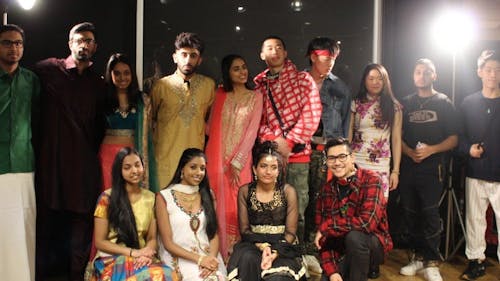Global Fashion Showcase celebrates stylish side of cultures

New York Fashion Week (NYFW) is in full-force in Manhattan, but the Fashion Organization of Retail and Marketing (FORM) brought the catwalk to New Brunswick with their Global Fashion Showcase on Wednesday.
The show was part of the organization's annual campus fashion week featuring a variety of fashion-focused events, from showcases to workshops to conversations with guest speakers. All proceeds from the showcase will go toward a fundraiser for Dress for Success, a nonprofit organization that provides professional attire for low-income women.
The student organization kicked off its first annual fashion week in 2016 with a fashion show that promoted the designs of local, Rutgers-affiliated designers and brands. This time around, FORM decided to showcase the diversity of the student body and wide range of cultures that make up the Rutgers community.
“We thought it would be a great idea to showcase the diversity of Rutgers students through a fashion show, especially since certain fashion garments and styles are unique to different cultures,” Phoebe Mak said, secretary of FORM and a Rutgers Business School junior. “We also wanted to create an opportunity to collaborate with other on-campus organizations, since fashion is something everyone can relate to.”
Currently the only fashion organization on campus, FORM offers a community for fashion-forward students and helps prepare industry-hopefuls for a career in the fields of fashion retail and marketing.
The Association of Punjabis at Rutgers University (APRU) opened the show, with members of the club acting as models. A male model graced the runway in a rich mahogany-colored kurta, a traditional shirt for Punjabi men that can be worn casually or formally.
Close behind followed a female model in a traditional orange and gold dress called a lehenga. With a high neckline, slight train and pencil pants underneath, the dress was comfortable yet elegant.
Another male model showcased the modern twists Punjabi people can choose to put on their traditional dress by pairing his long, bedazzled kurta with athletic sneakers.
The last model to represent APRU gracefully wore a bright pink sari complete with gold jewelry and makeup.
Next to present was RU Sif Sangam, the South Indian organization on campus. A young woman from the club modeled a green and gold sari, a traditional staple for Indian women that translates to “strip of cloth” in Sanskrit. Ideal for warm climates and worn in all different kinds of styles, the sari is worn by women in many different regions of India, Pakistan and Sri Lanka.
Another female model wore a decorative lehenga choli, a co-ord dress with a midriff-grazing gold top and long, orange high-waisted skirt. The mismatched top and bottom is a trend within the culture, and the dress is almost always accented with accessories and jewelry.
One woman to grace the runway wore a three-piece dress called a half saree: A skirt, a top and a scarf that wrapped around her shoulder down to her hips. The model embellished the royal blue and gold dress with a belt, showing the different ways traditional dresses can be styled.
Almost every garment showcased by the club was accented with metallic gold tones. The last two looks were a long black dress and a colorful plaid dress, two styles that have become popular among the South Indian youth culture.
Members of FORM closed the show with modern takes on clothing and styles from their individual cultures.
One model from Chengdu, China wore an outfit almost exclusively made up of pieces from 1807, a popular streetwear brand based in his hometown.
Another model from Chengdu mixed 1807 pieces with clothing by American designer Thom Brown, a popular label in China and accessorized with a jade stone necklace. “If you’ve ever been to Chengdu, you’ll see the presence of 1807,” the host of the show said.
Connor Shah, the event planner for FORM, modeled Japanese streetwear brand A Bathing Ape, Japanese selvage denim and a traditional furoshiki to honor his Japanese heritage.
Models representing FORM also showcased their creativity and eyes for style. One model paired a Balenciaga denim jacket with streetwear, merging a luxury name with an edgier look. Another model was completely "thrifted" out in secondhand and consignment clothing, accessorized with a custom Gucci baby bottle made by a local Indian designer.
NYFW has still only just begun, and FORM’s fashion week is still going strong. Thursday night the organization will be hosting a Thrift Shop Showcase in partnership with New Brunswick thrift store Simuel’s Closet. Not only will the show feature curated, one-of-a-kind and vintage items, it will also raise money and awareness for the store’s nonprofit organization.



